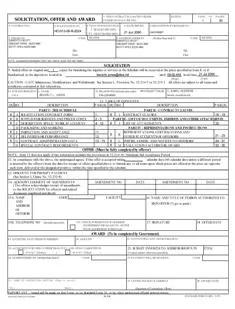Understanding the content and structure of a Government RFP, as shown below, enables you to write better proposals. The content of a U.S. Federal Government RFP is mandated by the Federal Acquisition Regulation (FAR). The FAR is a very lengthy and detailed set of rules that defines what must go into a Federal RFP and how it must be structured, as well as the acquisition and RFP process. Government RFPs that are based on the FAR are broken down into sections that are identified by letter (A - M).
The key to reading Government RFPs is to understand what is in each of these sections. The best way to read a Government RFP is not in order. And if you know what is in each section you can go straight there and save yourself tons of time. Here is a list of what is in each section:
Section A. Information to offerors or quoters
Section A of the RFP often appears as a one-page form. It is essentially the cover page of the RFP. It identifies the title of the procurement, procurement number, point of contact (POC), how to acknowledge amendments, and how to indicate “No Response” if you decide not to bid.
Section B. Supplies or Services and Price/Costs
Section B of the RFP defines the type of contract and provides instructions for how you should provide your pricing data. It identifies Contract Line Items (CLINs) and Subcontract Line Items (SLINs) that identify billable items. It also describes the period of performance, identifies option periods (if any), and provides cost and pricing guidelines. This section is often presented and responded to in a tabular form.
Section C. Statement of Work (SOW)
Tells you what the Government wants you to do or supply. It provides the requirements for your products or services. Sometimes this section or information related to it is contained in a separate appendix in Section J.
Section D. Packages and Marking
Defines how contract deliverables such as reports and material will be packaged and shipped or delivered. While it may not impact some projects, for others this information may affect costs and raise logistics issues.
Section E. Inspection and Acceptance
Describes the process by which the Government will officially accept deliverables and what to do if the work is not accepted. This can also affect costs and identifies tasks you must be prepared to undertake.
Section F. Deliveries or Performance
Defines how the Government Contracting Officer will control the work performed and how you will deliver certain contract items.
Section G. Contract Administrative Data
Describes how the Government Contracting Officer and your firm will interact and how information will be exchanged in administration of the contract to ensure both performance and prompt payment.
Section H. Special Contract Requirements
Contains a range of special contract requirements important to this particular procurement, such as procedures for managing changes to the original terms of the contract, government furnished equipment (GFE) requirements, and government furnished property (GFP) requirements.
Section I. Contract Clauses/General Provisions
Identifies the contract clauses from the FAR that are incorporated by reference in the RFP. These clauses will be incorporated into the contract. While it doesn’t require a separate response, its terms will be binding.
Section J. Attachments, Exhibits
Lists the appendices to the RFP. These attachments can cover a wide range of subjects from technical specifications through lists of GFE. It generally is used to provide data you need in order to respond to the Statement of Work.
Section K. Representations/Certifications and Statements of Offerors
Contains things that you must certify to bid on this contract. These can include things such as certification that you have acted according to procurement integrity regulations, your taxpayer identification number, the status of personnel, ownership of your firm, type of business organization, authorized negotiators, that your facilities are not segregated, that you comply with affirmative action guidelines, whether you qualify as a small business, disadvantaged business, and/or women-owned business, etc.
Section L. Proposal Preparation Instructions and Other
Provides the instructions for preparing your proposal. These include any formatting requirements, how they want the material organized/outlined, how to submit questions regarding the RFP or procurement, how the proposal is to be delivered, and sometimes notices, conditions, or other instructions. You should write your proposal by following these instructions precisely.
Section M. Evaluation Criteria
Defines the factors, subfactors, and elements used to “grade” or score the proposal. Proposals are scored and then cost is considered to determine who wins the award and gets the contract. The evaluation criteria will tell you which elements are the most important for how your proposal will be scored.



Let's discuss it!
You can post now and register later. If you have an account, sign in now to post with your account.
Note: Your post will require moderator approval before it will be visible.